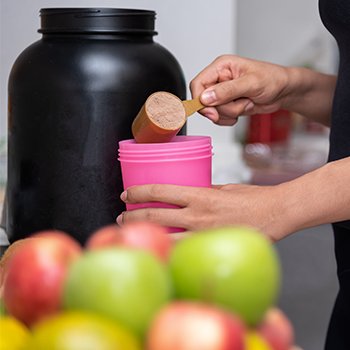โปรตีนใส: มิติใหม่ในการผลิตเครื่องดื่มที่ดีต่อสุขภาพ Clear Protein: A New Dimension in Producing Healthy Beverages
1932 Views |

โปรตีนใส: มิติใหม่ในการผลิตเครื่องดื่มที่ดีต่อสุขภาพ
Clear Protein: A New Dimension in Producing Healthy Beverages
By: ดร. อติกร ปัญญา
Atikorn Panya, Ph.D.
Functional Ingredients and Food Innovation Research Group
National Center for Genetic Engineering and Biotechnology (BIOTEC)
atikorn.pan@biotec.or.th
แนวทางและความท้าทายในการพัฒนาเครื่องดื่มโปรตีนใส
การพัฒนาเครื่องดื่มโปรตีนให้มีความใสเป็นเรื่องที่ท้าทาย และจำเป็นต้องเข้าใจถึงปัจจัยต่างๆ ที่ก่อให้เกิดความขุ่น ซึ่งเกิดจากการกระเจิงแสง (light scattering) ในเครื่องดื่ม ยกตัวอย่างปัจจัยพื้นฐานที่เกี่ยวข้องกับการกระเจิงแสง เช่น 1. ชนิดของอนุภาคนั้นเป็นแบบแขวนลอย (disperse) หรือละลายได้ (dissolve) 2. จำนวนหรือความหนาแน่นของอนุภาค (particle density) 3. ขนาดของอนุภาค (particle size) และ 4. ค่าดัชนีการหักเหของแสงวัสดุ (Reflective Index; RI) โดยพื้นฐานถ้าโมเลกุลโปรตีนอยู่ในสภาพที่สามารถละลายในน้ำได้เกือบ 100% และปราศจากสิ่งปลอมปนอื่นๆ ที่ทำให้เกิดอนุภาคแขวนลอยจะทำให้ได้เครื่องดื่มโปรตีนที่มีความใสมากที่สุด ซึ่งจะสังเกตได้ว่าโปรตีนที่นำมาใช้ในการพัฒนาเครื่องดื่มโปรตีนใสจะเป็นโปรตีนที่มีคุณภาพดีและมีความบริสุทธ์สูง โดยปัจจัยที่ส่งผลให้โปรตีนสามารถละลายน้ำได้สูงสุด นั่นคือ สภาวะความเป็นกรด-ด่างของเครื่องดื่ม ผู้พัฒนาจำเป็นต้องรู้จักค่าการละลายของโปรตีนที่ใช้ในแต่ละช่วง pH โดยพื้นฐานควรมีการปรับค่า pH ให้ไกลจากจุดไอโซอิเล็กทริก (isoelectric point; pI) ซึ่งเป็นจุดที่โปรตีนมีค่าการละลายต่ำสุด ในอุตสาหกรรมอาหารส่วนใหญ่มักนิยมปรับค่า pH ของเครื่องดื่มให้มีความเป็นกรดซึ่งอยู่ในช่วง pH 3-4 มากกว่าที่จะปรับช่วงให้มีความเป็นด่างที่ pH 8-10 เนื่องจากการพัฒนารสชาติเครื่องดื่มโปรตีนให้มีความเป็นกรดจะง่ายกว่า หากสังเกตเครื่องดื่มโปรตีนใสในท้องตลาดส่วนใหญ่จะเป็นเครื่องดื่มที่มีรสชาติผลไม้ต่างๆ นอกจากการปรับความเป็นกรด-ด่างเพื่อเพิ่มการละลายของโปรตีนแล้ว ผู้ผลิตโปรตีนทางการค้านิยมเติมสารลดแรงตึงผิว (surfactant) บางชนิด ร่วมกับการให้ความร้อนเล็กน้อยเพื่อเพิ่มการละลายของโปรตีน เนื่องจากสารลดแรงตึงผิวมีความสามารถในการเข้าไปคลายโครงสร้างของโปรตีน (protein-unfolding) ได้ แต่อย่างไรก็ตาม มีข้อควรระวังในการพัฒนา คือ ควรจะเลือกใช้ชนิดและปริมาณของสารลดแรงตึงผิวที่เหมาะสม มิเช่นนั้นจะเกิดปัญหาอื่นๆ ตามมา เช่น กลิ่นรสผิดเพี้ยน (รสคล้ายสบู่) และการเกิดฟองที่มากเกินไป เป็นต้น
Guidelines and challenges of clear protein drinks development
Developing clear protein drinks is challenging, requiring an understanding of various factors that cause turbidity. This turbidity arises from light scattering within the drink. For instance, fundamental factors influencing light scattering encompass 1) the type of particle suspended (dispersed) or soluble (dissolved), 2) the particle density, 3) the size of the particle, and 4) the refractive index (RI). Essentially, if the protein molecule can dissolve in water almost entirely and is free from other contaminants, it causes the particles to suspend, resulting in a clear protein drink. It is worth noting that the proteins utilized in the development of clear protein drinks must be of high quality and purity. The factor enabling proteins to dissolve maximally in water is the acidity-alkalinity of the drink. Product developers must ascertain the protein solubility used at various pH ranges. Ideally, the pH should be adjusted far from the isoelectric point (pI), where the protein exhibits low solubility. In the food industry, it is often preferable to adjust the pH of beverages to a more acidic range, around pH 3-4, rather than an alkaline range, around pH 8-10, due to the ease of developing protein beverage flavors with acidity. Notably, most clear protein drinks on the market are infused with various fruit flavors. In addition to adjusting acidity and alkalinity to enhance protein solubility, commercial protein manufacturers often incorporate specific surfactants along with mild heating to further enhance protein solubility. Surfactants possess the ability to unfold protein structures. However, caution in development; the suitable type and quantity of surfactant must be selected. Otherwise, issues like altered flavor (soap-like taste) and excessive foaming may arise.






